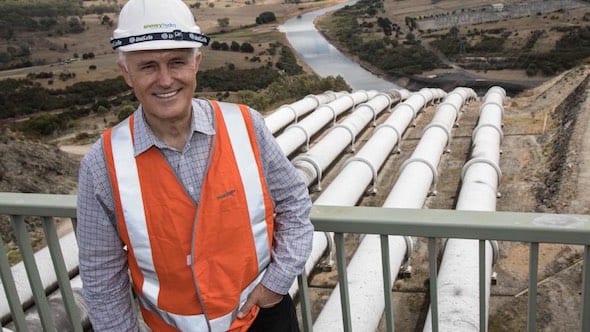Snowy 2.0, or Snow Job? Prime Minister Malcolm Turnbull has given gushing praise to his pet project, the Snowy 2.0 pumped hydro scheme, despite its soaring costs, questionable economics, and fears it may do little more than use coal power to push water uphill.
The feasibility study was partially released on Thursday, revealing that costs for the proposed 2GW, 365GWh pumped hydro scheme had more than doubled from $2 billion to a range of $3.8 billion to $4.5 billion.
The costs could rise more, depending on whether it can overcome serious engineering hurdles that it has not yet analysed, and if it needs a bigger shovel.
These costs do not include the cost for new poles and wires into Victoria and NSW, which would add another $2 billion to be paid by consumers.
A final investment decision will not be made until late 2018. But analysts question how it could possibly work, unless it receives significant payments for acting as “reserve capacity” – most likely through the proposed National Enegy Guarantee.
It reinforces the view that the NEG is a scheme designed with a specific purpose – to support Turnbull’s vanity project, as we wrote a month ago. Crucially, chapters on the scheme’s economics, detailed costs and business case have not been released.
Clearly, though, the board of Snowy Hydro – whose shareholders include the federal, NSW and Victoria governments – see the project as an “us or them” proposition – the “them” being competitors such as battery storage, other pumped hydro schemes, or the smart technologies they did not even mention: demand management and energy efficiency.
The glossy booklet and feasibility study suggested Snowy 2.0 could use excess wind capacity overnight to pump water uphill to reservoir, before letting it down again to spin turbines and generate electricity for use at times of peak demand or higher prices.
But Australia is a long way off having such significant amount of excess wind, or even solar capacity, as ITK analyst and RenewEconomy contributor David Leitch explains here.
“As the NEM is current configured Snowy 2.0 will increase electricity demand, and increase CO2 output,” Leitch writes.
“Of course, this would could change in a largely renewable world but at first blush when renewables penetration is 20-30 per cent there is a 60-70 per cent chance of pumping being powered by coal.”
Turnbull’s NEG proposes no little or no new wind or solar in the decade from 2020 to 2030, and his government made it clear this week there would be no change in policy or emissions targets.
Currently, about 5GW of wind and solar has been committed or financed to meet the renewable energy target, but this won’t be enough to drive Snowy’s pumps, and the industry faces an investment cliff unless the NEG design is changed significantly, and emissions targets ramped up.
Energy analysts say the idea of a large pumped hydro scheme is not a bad one. Indeed, RenewEconomy wrote back in March that it was a potential turning point in the energy debate, particularly its focus on “dispatchable rather than “base-load” generation.
But that assumed a willingness to use the project to push for more renewables, and there is no evidence of that in government policy then, or since.
Chris Dunstan, from the Institute of Sustainable Futures, says the feasibility report’s claim that Snowy 2.0 can enable new wind and solar “in a manner not otherwise economically achievable” is simply not true.
Demand Response and time varying prices would be much more economically achievable, Dunstan says, in the same way as they would for replacing the Liddell coal generator.
“Snowy is likely to increase the carbon intensity of the energy market, at least in the short to medium term as Snowy 2.0 will most likely be powered by coal not renewable energy,” Dunstan says.
“In summary, there may be a case for Snowy 2.0 when we reach say greater than 50 per cent renewables share of generation, and we have used other cheaper flexible resources first. But this is not so now and is unlikely to occur before 2030.
“If we really want more flexible capacity now, then let’s have a transparent competitive process to find the lowest cost solution. And isn’t that what the NEG is supposed to do?.
Analysts also question, however, the economics of lumping so much capacity in one place, and why so much is needed if Australia continues to portray renewable energy levels of 50 per cent or more as “reckless.”
This was a theme taken up by Labor’s climate spokesman Mark Butler, who pointed to the total costs of at least $6.5 billion, likely increases and delays, and its likely support of coal under Coalition policies.
“The feasibility study also makes it clear Snowy 2.0 should be linked to Renewable Energy Zones – a Labor policy to support our 50 per cent renewable energy target that the Government has refused to endorse,” Butler says.
There are also questions about government intervention here, and how it can be financed. The document says the project will only work if it stops paying dividends to its government owners – so there is an effective tax-payer subsidy.
ITK analyst David Leitch says it is clear that Snowy 2.0 could not operate in the “merchant market”, it would not be able to make much money. So it will almost certainly rely on long term “reliability” contracts being contemplated by the NEG.
It puts the federal government in a clear conflict of interest – it is proposing to design and legislate a scheme whose biggest beneficiary is likely to be its own asset. No amount of fluorescent shirts and hard hats can overcome that issue.
Energy minister Josh Frydenberg however, insisted that the scheme would push prices down overall, and would add to the value of solar and wind power.
Some observers agreed, noting that the costs to the system would be significantly cheaper than, say household solar and battery storage.








